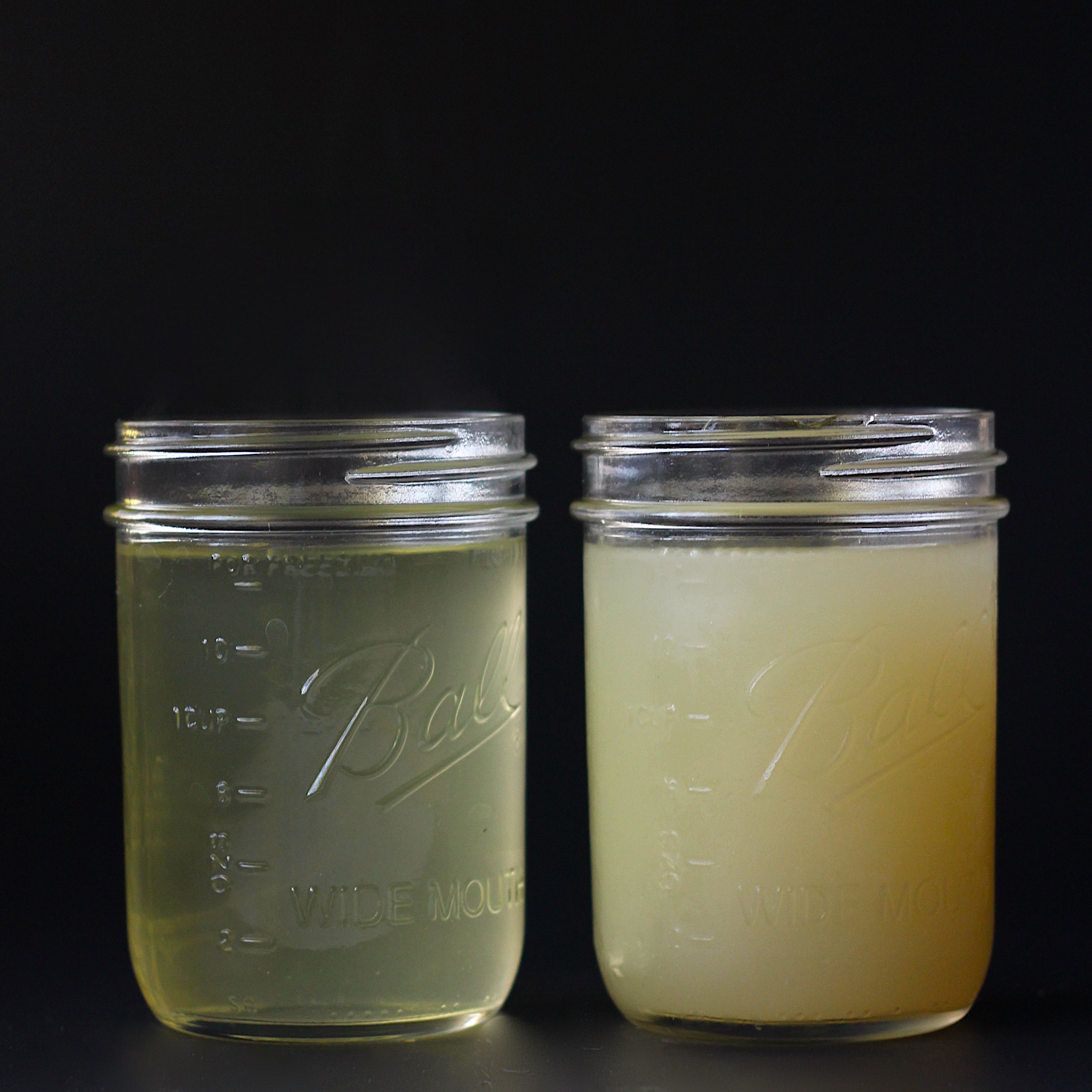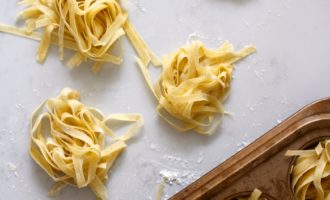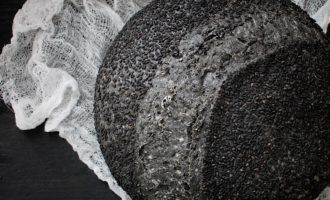Homemade Chicken Broth and Stock
I love this time of year. When the air gets really crisp but we still have a lot of days of sunshine, and I just want to make a big pot of soup and a loaf of crusty bread for dinner every night. The funny thing is, I used to hate soup. I remember complaining as a teenager that soup wasn’t a real meal, because … well, I don’t remember why I said that, actually. And then one day my sister made this amaaaaaaazing creamy chicken noodle soup, and I was sold. First of all, cream. Am I right? And second, she made her own broth. For meals as simple and basic and everybody-has-a-good-recipe as chicken noodle soup, you need to start with quality ingredients. And we all know from the title of my blog that I’m just a little bit passionate about making food from scratch. There are a few reasons for that:
- Homemade food just tastes better.
- It’s so much less expensive to make things yourself.
- I get to control what I put into my food.
- And, I guess I’m one of those weirdos that actually really thinks it’s fun.
Next time you’re thinking of buying a can or carton, read the ingredient list. I’m quite happy with my 4-5 ingredient list of real food + water, thank you very much.
 And you’re probably wondering what the difference between broth and stock might be. The two words are often used interchangeably. Basically, broth is lighter, relies on the meat more than bones, almost always has vegetables added, and is often cooked for a shorter amount of time. I like to use it for lighter, brothier soups, and for cooking grains like rice and quinoa, when you don’t want it to take over more delicate flavors. Stock, on the other hand, is made with little or no meat, but with the bones instead, and vegetables are optional (and if used, they are added only in the last hour or so of cooking to prevent bitterness). The bones are often roasted first, and are cooked in the water for hours to pull out as much of the amazing nutrients and flavor from them as possible. A little splash of vinegar (I always use organic raw apple cider vinegar) encourages the bones to release the minerals and collagen and good stuff that makes stock so good for you, and after such a long cooking time, the flavor of the vinegar isn’t noticeable at all, so I recommend it. Stock is great used in heartier soups and stews, where it’s more robust flavor will contribute to the resulting dish. But really, they both work great in almost any application.
And you’re probably wondering what the difference between broth and stock might be. The two words are often used interchangeably. Basically, broth is lighter, relies on the meat more than bones, almost always has vegetables added, and is often cooked for a shorter amount of time. I like to use it for lighter, brothier soups, and for cooking grains like rice and quinoa, when you don’t want it to take over more delicate flavors. Stock, on the other hand, is made with little or no meat, but with the bones instead, and vegetables are optional (and if used, they are added only in the last hour or so of cooking to prevent bitterness). The bones are often roasted first, and are cooked in the water for hours to pull out as much of the amazing nutrients and flavor from them as possible. A little splash of vinegar (I always use organic raw apple cider vinegar) encourages the bones to release the minerals and collagen and good stuff that makes stock so good for you, and after such a long cooking time, the flavor of the vinegar isn’t noticeable at all, so I recommend it. Stock is great used in heartier soups and stews, where it’s more robust flavor will contribute to the resulting dish. But really, they both work great in almost any application.
In both cases, though, You add everything to the pot, bring to a boil, then drop to a simmer. Don’t be tempted to boil for the whole length of time to speed up the process. You’ll end up with tough meat instead of it being fall-off-the-bone tender, and your liquid will be cloudy and even a little viscous sometimes. And the flavor is compromised. The goal is a clear liquid and pure flavor, which is only achieved through gentle simmering.
 See the difference? On the right is a boiled broth and the left is simmered. And the simmered broth is not lacking in flavor by any means. If anything, it had a more pronounced, clean, “chicken-ey” flavor. Oh, and I know I’m going to sound like a broken record here, but I only use free range, organic chicken when making broth or stock. I have a lot of reasons for this, but the biggest honestly is flavor and smell. Years ago before I switched to free range organic chicken, I used to hate the smell in my house on days I’d make stock or broth, it was kind of gamey and smelled off. Now, it’s sweeter and smells like … well, a chicken. I figure the bad smells in the conventionally raised chickens has to do with the additives once processed and the feed and antibiotics and hormones and the fact that those chickens never walked, let alone saw the light of day. I realize the cost difference is significant, but you get an entire poached chicken, and (if you plan right) 2 whole gallons of broth and stock for the price of one chicken, so I think it’s worth it.
See the difference? On the right is a boiled broth and the left is simmered. And the simmered broth is not lacking in flavor by any means. If anything, it had a more pronounced, clean, “chicken-ey” flavor. Oh, and I know I’m going to sound like a broken record here, but I only use free range, organic chicken when making broth or stock. I have a lot of reasons for this, but the biggest honestly is flavor and smell. Years ago before I switched to free range organic chicken, I used to hate the smell in my house on days I’d make stock or broth, it was kind of gamey and smelled off. Now, it’s sweeter and smells like … well, a chicken. I figure the bad smells in the conventionally raised chickens has to do with the additives once processed and the feed and antibiotics and hormones and the fact that those chickens never walked, let alone saw the light of day. I realize the cost difference is significant, but you get an entire poached chicken, and (if you plan right) 2 whole gallons of broth and stock for the price of one chicken, so I think it’s worth it.
And, as with a lot of my favorite from-scratch basics, it freezes really well. I freeze in 2-4 cup portions and stock up my freezer for a week’s worth or more of soup. If you can find really great zip-top freezer bags that you trust won’t leak, fill the bags, try to get as much air out as possible, then stack flat in your freezer. Once frozen solid, you can line them up vertically like a bookshelf. If you’re concerned at all about leakage, go with good old fashioned plastic or glass containers. Just make sure the glass containers you use are labeled “freezer-safe”. I’ve made the mistake of ignoring that label, and had shattered glass all over my freezer with a solid jar-shaped broth ice cube sitting in the middle of the wreckage.


- 1 3-4lb (preferably organic, free range) whole chicken, neck and giblets removed
- 1-2 carrots, tops removed and scrubbed clean
- 1-2 stalks of celery, washed and tops and root ends trimmed
- 1-2 large yellow onion, root end trimmed, peeled, and cut in half
- 1-2 cloves garlic, smashed and peeled, optional
- 2 gallons water, seperated
- 2 tablespoons raw apple cider vinegar, optional
- In a large stock pot, add chicken, 1 carrot, 1 celery stalk, 1 onion, 1 clove of garlic (if using), and 1 gallon of water. Bring to a boil, immediately drop to a simmer, and let simmer for 1-2 hours. Occasionally skim off the scum that rises to the surface and discard. Turn off the heat, pull out the chicken (it will probably fall apart, so be careful) and let cool. Strain the broth through a fine mesh strainer lined with cheese cloth and skim the fat off of the top.*
- Once the chicken is cool enough to handle, pull the meat off of the bones and reserve for other uses. Take the bones, clean them of cartilage and leftover meat. At this point you can roast them on a baking sheet in a 450°F oven for 20-30 minutes if you want to. It will result in a darker, more richly flavored stock, but it's not necessary.
- In a large, clean stockpot, add the chicken bones, remaining gallon of water, and vinegar (if using). Bring to a boil, immediately drop to a simmer, and let simmer for at least 4-6 hours or even up to 24 hours. Occasionally skim off the scum that rises to the surface and discard. In the last hour or so of cooking, add the remaining carrot, celery, onion, and garlic, if using. Strain the stock through a fine mesh strainer lined with cheesecloth, and skim off any fat*, which should be minimal.
- You can use both the broth and stock immediately, refrigerate for up to 3 days, or freeze for up to 3 months.
- *I have 2 favorite ways to skim the fat. You can either use a fat separator, or simply place the chicken broth in the fridge and once it's completely chilled, strain the broth again. The fat will solidify, so it will get caught in a fine mesh strainer.
Bragg Unfiltered Organic Raw Apple Cider Vinegar
Comments
- Creamy Tomato Basil Soup - Scratch Eats - […] homemade. And chicken or vegetable work beautiful here. I have a recipe of homemade chicken stock here. And maybe…




Laura
November 10, 2015
I’ve heard the fat is really good for brain development (kind of like giving kids whole milk) and is helpful for kids with brain issues like ADHD. What are your thoughts on leaving the fat in the stock and broth? I know it will make a “greasy” soup, but do you know of any reason not to strain out the fat other than the clarity and flavor?
Lillian
November 17, 2015
Laura, you know me and whole milk, that’s all I buy. But honestly, I haven’t thought much about keeping the chicken fat from my stock, thank you for bringing that up! I usually skim it and just give it to my dog, ha! I’m going to read up on the benefits of that, so much to think about. I often keep the rendered fat from other meats like bacon (I figure if I’m going to spend the money on local, free-range, uncured bacon, I better get my money’s worth), why not chicken fat, right? I do think if I were to reserve it, I’d still separate it from the stock and broth, just because I don’t want the extra greasiness, like you mentioned. But keeping it for other uses? Yum. Thanks for your comment!